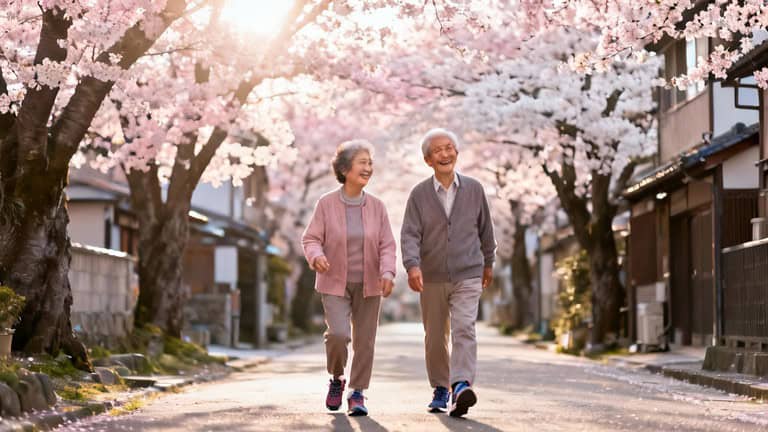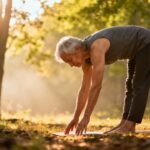Have you ever wondered why people in Japan seem to age so gracefully, remaining active and vibrant well into their 80s and 90s?
While many Americans in their 50s struggle with mobility issues, Japanese seniors continue walking to markets, climbing stairs, and maintaining active lifestyles with ease. The secret isn’t in some magic supplement or exotic diet—it’s in their daily walking habits.
The statistics tell a compelling story: the average person in Japan walks over 7,000 steps daily, while Americans average closer to 3,000.
This simple difference in daily movement contributes significantly to Japan’s remarkable longevity rates and better health outcomes among seniors.
7 Life-Changing Benefits of Daily Walking After 50
1. Supercharge Your Heart Health
Walking daily is like charging your heart’s battery. In Japan, where walking is integrated into daily life, heart disease rates are less than half of those in the United States.
The American Heart Association confirms that just 30 minutes of walking daily can reduce your risk of heart disease and stroke by up to 35%.
This gentle activity lowers blood pressure, improves circulation, and strengthens your heart muscle without the intensity of high-impact exercises. Your heart doesn’t need CrossFit—it just needs consistent movement around the block.
2. Boost Your Brain Power and Memory
Forget expensive brain supplements—your sidewalk might be the best cognitive enhancer available. Research from Tokyo University shows that walking 6,000 steps daily can slow brain aging and improve memory retention in people over 60.
When you walk regularly, blood flow to your brain increases, new neural connections form, and stress hormones decrease.
The University of British Columbia found that older adults who walk just three times weekly experience improved hippocampus size—the brain region responsible for memory storage.
3. Naturally Regulate Blood Sugar
Here’s a fascinating paradox: Japanese people eat white rice with nearly every meal yet have significantly lower diabetes rates than Americans. The difference lies in their post-meal walking habits.
The CDC confirms that walking after meals can substantially lower blood glucose levels. Harvard research shows that brisk walking just 30 minutes daily reduces type 2 diabetes risk by 30%.
When you walk, your muscles use glucose for energy, and your body becomes more sensitive to insulin—no pills or needles required.
4. Elevate Your Mood Naturally
Life after 50 brings unique stresses—health concerns, aging parents, adult children—and sometimes it feels overwhelming. Walking provides a natural mood boost without prescription side effects.
When you walk, your brain releases endorphins and serotonin, your body’s built-in mood elevators.
JAMA Psychiatry published research showing that walking just 90 minutes weekly significantly reduces depression symptoms in older adults.
Japan’s lower rates of late-life depression, despite longer lifespans and elder care responsibilities, highlight the mood benefits of daily movement.
5. Lubricate Your Joints
Your joints function like door hinges—they rust if they don’t move regularly. Walking serves as natural WD-40 for your knees, hips, and ankles. This gentle movement increases circulation to cartilage, delivering nutrients and flushing out inflammation.
The Arthritis Foundation confirms that walking reduces arthritis pain, improves flexibility, and slows joint degeneration.
Regular movement stimulates synovial fluid production, your body’s natural joint lubricant. Many people in their 60s who start walking report that their joints feel better than they did a decade earlier.
6. Strengthen Your Immune System
Walking acts as your immune system’s personal trainer, working more effectively than expensive supplements. Japan’s active seniors experience lower rates of respiratory infections and seasonal flu compared to their American counterparts.
Research from Appalachian State University reveals that people walking 30-45 minutes daily have 43% fewer sick days during cold and flu season.
Walking boosts white blood cell production, particularly natural killer cells that detect and destroy viruses and early cancer cells. The gentle movement also stimulates your lymphatic system, helping clear toxins from your body.
7. Slow the Aging Process
Forget expensive anti-aging creams and treatments—your most effective youth-preserving tool might be right outside your door.
Walking regulates hormones, improves sleep quality, boosts digestion, and reduces inflammation—all factors that visibly impact aging.
Research published in Frontiers in Aging Neuroscience found that walking increases telomerase activity, which protects your cells from aging. This means your body literally slows its aging process.
Many regular walkers report looking and feeling younger than their chronological age, proving that the real “glow-up” comes from daily movement, not skincare routines.
How to Start Walking After 50
Beginning a walking routine doesn’t require dramatic changes. Start with these simple steps:
- Begin with just 10 minutes daily around your neighborhood or local mall
- Wear comfortable shoes—no fancy gear necessary
- Choose cooler morning or evening hours for comfort
- Make it enjoyable with music, podcasts, or walking with friends
- Adopt the Japanese habit of walking after meals to aid digestion
- Focus on consistency rather than intensity
Important Safety Considerations
If you have recent surgery, severe heart conditions, or serious joint issues, consult your doctor before starting a walking routine. While walking is generally gentle and safe, individual health considerations should always come first.
The Simple Truth About Walking
Walking might seem ordinary, but its benefits are extraordinary. If walking were a medication, it would be the most prescribed drug in America.
This single habit improves heart health, brain function, mood, joint mobility, immunity, and slows aging—all with zero side effects. The Japanese approach reveals a crucial insight: they don’t walk to exercise; they walk to live.
In America, we’ve designed everything for convenience, often at the cost of our health. The solution isn’t complicated—it’s as simple as putting one foot in front of the other.
Start small, stay consistent, and walk like your quality of life depends on it—because the evidence suggests it truly does. Your journey to better health begins with that first step out your door.








